Statistical Accounts of Arbroath
The Old or First Statistical Account of the parish of Arbroath is dated 1792 whilst the New Account is dated 1833.
PARISH OF ARBROATH.
(County of Forfar.—Presbytery of Arbroath.—Synod of Angus and Mears.)
By the Reverend Mr George Gleig.
Town, &c.
ABERBROTHOCK, or Arbroath, is a royal burgh, situated on the discharge of the small river of Brothock into the sea, from whence it has its name, Aber implying such a situation. In conjunction with Aberdeen, Bervie, Montrose, and Brechin, it sends a member to Parliament. The post-road from Edinburgh to Aberdeen runs through it. It is distant 17 miles from Dundee, and 12 from Montrose. It is the general opinion, that it was erected into a royalty by King William the Lion about the year 1186; but this cannot be properly ascertained, owing to the loss of the original charter, which was taken away by force out of the Abbey of Arbroath, where it was lodged in the time of the civil wars, during the minority of James VI by George Bishop of Moray, called Postulat of Arbroath. It was, however, confirmed in all the privileges of a royal burgh, which it had formerly enjoyed, by a novodamus granted by James VI in the year 1599. The town is pleasantly, situated within an amphitheatre of a ridge of small hills, enjoying a south exposure, and having a fair and extensive prospect of the Lothian hills, the east coast of Fife, and the entries into the Frith of Forth, and the river Tay. The prospect towards the north is bounded by the Grampian Hills. Few places equal it in point of situation. It is governed by a provost, two bailies, and 16 counsellors. The dean of guild and deacon convener of the trades are members of council ex officio. Besides the town-clerk, there are 5 writers, who are notaries public, and 2 messengers at arms. The revenue of the town amounts to about 800l. which arises principally from rents of land, harbour dues, town's mills, and 2 pennies Scotch on each pint of ale sold within the royalty. There are 7 trades incorporated; smiths, glovers, taylors, weavers, shoemakers, wrights, and bakers.
Trade.—Before the year 1736, Arbroath had little or no commerce, unless a little traffic in fish, and a kind of contraband or smuggling trade deserve the name. It had no manufactures; and any piece of cloth that was made was carried to Montrose, and sold there. It imported nothing, except now and then a small cargo of wood from, Norway. Flax, iron, and other commodities, were purchased by the inhabitants from the merchants in Montrose and Dundee. A few years subsequent to that mentioned above, several gentlemen of property jointly undertook to establish the manufacture of Oznaburghs, and other brown linens here, and to import their own materials. They laid out considerable sums of money on different kinds of machinery, which were executed on a very complete and extensive scale. Success attended their spirited exertions; and, at that time, the Arbroath fabrics procured a superiority, and commanded a sale, in preference to any other of the kind, which they still hold. From this establishment, the rise and progress of the trade and manufactures of Arbroath are to be dated. The principal manufactures are sail-cloth, Oznaburghs, and other brown linens. From November 1790, to November 1791, 1,055,303 yards of the two last were manufactured in the town and stamp-office district, which extends about 6 or 8 miles round the town, equal in value to 39,660l. 6s. 10d. There is likewise yearly manufactured in the town, sail-cloth to the same amount; and nearly 500 looms are employed. The greatest part of the linen and sail-cloth is shipped for London. A small part is sent to Glasgow and Dundee. The principal imports are flax and hemp from Russia, and wood and iron from Norway and Sweden. Of the two first, there were imported last year from 700 to 800 tons; and wood and iron to the value of 4000l. A very considerable trade is likewise carried on in lime and coals. Of the former, there are unloaded at the harbour about 18,000 bolls of shells ; and from 6000 to 8000 tons of the latter yearly. This quantity will not seem so great, when it is considered that this town not only supplies its own neighbourhood, but sends a great quantity of coals to Forfar, Brechin, and their neighbourhood. A repeal of the coal-tax would considerably affect the revenue of this town, and be a loss to individuals, who deal solely in the coal-trade; yet the people are not so selfish as to throw any obstacle in the way of a repeal, so ardently desired by their northern neighbours, nor so blind to their own interest as to solicit its abolition. About 18,000 bolls of barley are yearly shipped here, and the trades import about 3000 bolls of oat-meal. There is a tan-yard, which employs 6 men; and hides are yearly dressed, to the value of 2500l. During the late war, and some time prior to it, a great number of shoes were exported; but, since the peace, that trade has almost, if not entirely failed. A short time ago, a cotton manufactory was established, which employs 18 men, women, and children. Yarn is spun to the value of 1000l. and 6 looms weave of calicoes to the amount of 500l. yearly. There is also lately established here a manufacture of particular kinds of brown linens, never attempted in this part of the country. The number of looms employed is 18. The cloth is mostly used by coachmakers and upholsterers; and the proprietor has a shop in London for selling it. One of the kinds is remarkable for its thinness, and more properly may be termed gauze than linen, of which a person will weave 40 yards a day, though it is yard wide. The common price of this last is 4d. per yard. In the year 1740, a thread manufactory was established, which was for many years carried on to a great extent, and turned out to good account. By it thousands of people gained a livelihood. For some time past it has been greatly on the decline, owing to the high prices of flax, the great rise on spinning, the high wages allowed to labourers in the Oznaburgh and linen manufactories, and more especially to the want of a proportionable rise of price for the thread in the London market. From these causes, the thread trade in this place may be said to be turned thread bare. But, though it has failed, trade goes briskly forward; and, to show its increase, the increase of the imports and exports, it is only necessary to mention, that the harbour-dues were this year (1792) let at public roup for 293l. exclusive of the guildry-dues, when 40 years ago they did not bring more than 70l. guildry-dues included.
Harbour.—The harbour was originally at the end of the East causeway, and built in the year 1194. There is yet extant an agreement between the abbot of Arbroath and the inhabitants, concerning the building of it, by which both parties were bound to contribute their proportions; but the largest share fell to the abbot, for which he was to receive an yearly tax, payable out of every rood of land lying within the burgh. The pier was built of wood, and but ill constructed to defend the vessels in stormy weather, from the heavy surges which roll on shore. In the year 1725, a brief was obtained for building a new one, which is situated a little to the west of the old. It is strongly built of stone all round, small, but very commodious, and so constructed that a vessel can lie to at any part of it, either to receive or discharge her cargo. It is likewise perfectly safe, being contracted at the entrance to the width of 31 feet, and defended by what is called the gates, which are 14 or 15 strong beams of wood, let down in a groove on each side, and locked in on the top by iron bars. These beams, which are easily put in or taken out in 15 minutes, by means of a crane made for the purpose, completely break the force of the sea, which runs into the harbour, so that it is fida flatio carinis. It is always dry at low water; but has a sluice on the north side, by which the water of Brothock is admitted, when it is thought necessary to clean it. At spring tides there is, at its entrance, a depth of 15 or 16 feet; and at neep tides, of 9 or 10 feet water.
In the year 1781, there belonged to this harbour no more than 17 or 18 vessels, making all together only about 900 tons; now there are 32 vessels, making 1704 tons, which employ about 160 seamen. There are besides two vessels on the stocks, together above 150 tons.
To this harbour belong also 3 fishing boats, besides the pilot boats, which employ 14 fishermen; but these depend upon a living more on what they make by pilotage, than on what they can earn in the fishing trade, which has mostly failed.
(During the late war, in the year 1781, the shipping on this coast was much annoyed by a French privateer, named the Fearnought of Dunkirk, commanded by one Fall. On the evening of the 23d of May, he came to anchor in the Bay, and fired a few shot into the town; after which salute, he sent a flag of truce on shore, with the following letter:
At sea, May twenty third.
“Gentlemen, I send these two words to inform you, that I will have you to bring to the French colour, in less than a quarter of an hour, or I set the town on fire directly; such is the order of my master the King of France I am sent by. Send directly the mair and chiefs of the town to make some agreement with me, or I'll make my duty. It is the will of yours.
{Addressed to} To Monsieurs Mair of the town called Arbrought, or in his absence, to the chief man after him in Scotland."
The Magistrates, wishing to gain time to arm the inhabitants, and send expresses to the neighbouring towns for military, gave an evasive answer to this letter, intimating, that he had mentioned no terms of ransom, and begging he would do no injury to the town, till he should hear from them again. Upon this Fall wrote a second letter, which is as follows:
At Sea, eigth o cloc in the afternoon.
"Gentlemen, I received just now your answer, by which you say I ask no terms. I thought it was useless, since I asked you to come aboard for agreement. But here are my terms; I will have 30,000l. Sterling at least, and 6 of the chiefs men of the town for otage. Be speedy, or I shoot your town away directly, and I set fire to it. I am, Gentlemen, your servant.
"I sent some of my crew to you; but if some harm happens to them, you'll be sure will hang up the main-yard all the preseners we have aboard.
To Monsieurs the chiefs men of Arbrought in Scotland.
The magistrates, before sending a return to this letter, having got some of the inhabitants armed, and some military from Montrose, set Fall at defiance, and ordered him to do his worst, for they would not give him a farthing. Terribly enraged, and no doubt greatly disappointed, he began a heavy fire upon the town, and continued it for a long time; but happily it did no harm, except knocking down some chimney tops, and burning the singers of those who took up his balls, which were heated. On the 24th he sent a third letter on shore, by some of our own people, whom he had captured at sea. It runs thus:
At Sea May 24th.
"Gentlemen, See whether you will come to some terms with me, or I come in presently with my cutter into the arbour, and I will cast down the town all over. Make haste, because I have no time to spare. I give you a quarter of an hour for your decision, and after I’ll make my duty. I think it would be better for you, Gentlemen, to come some you aboard presently, to settle the affairs of your town. You'll sure no to be hurt, I give you my parole of honor. I am your, &c.”
To this letter the magistrates sent a verbal message to Fall, that they would be glad to see him on shore, and hoisted a flag of defiance on the Ballast Hill. Finding his threats to be in vain, after firing some few ineffectual shot, he weighed anchor, and sailed in pursuit of some sloops which came into the offing, which he captured, but did not return.
To prevent all insults of this kind, from so mean an enemy, for the future, a battery was proposed to be built. A subscription was opened for this purpose, which was soon filled up. Government was applied to, and Captain Andrew Fraser was sent down to plan the work, which was quickly finished. The battery, mounting 6 12 pounders, is built somewhat in the form of a half-moon, of stone and lime, and faced with large banks of sods The platform is paved with stone, and below it there are vaults bomb-proof, for keeping powder and shot, with other necessaries. It is built on the Ballast Hill, between the harbour and the sea, and has a compleat command of the Bay, so that now no Fall, with his Fearnought, dare insult Arbroath with impunity.
Soil and Produce.—,The soil is various. On the northren extremity it is a thin muirish soil, with a clay bottom; about the middle it is black loam and hard on the shore, the ground is light and sandy. The whole has been much improved of late, and it produces excellent crops of wheat, oats, barley, pease, rye-grass, turnip,, potatoes, &c. About 27 years ago, the magistrates planted 110 acres of muir with Scotch firs, which are thriving very well, and in a short time will bring a considerable addition to the revenue of the town. The coast is flat and rocky, and, from the rocks, sea-weed is cut every third year, for the purpose of making kelp. The quantity made is very inconsiderable, and the emolument thence arising to the town not worth the mentioning.
Population &c.—In the year 1755, the numbers were 2098. In the year 1776, the number of souls in the parish amounted to 3943, the total amount this year, (1792) in town and country, is 4676, of which there are, in the country, 131, and 4545 in town. But to gain a complete list of the number of people in the town of Arbroath, we must add the number of souls in that part of it belonging to the parish of St. Vigeans, which is 638, and then the number of souls in the town is exactly 5183.
In this parish there are 517 females more than males. An exact register of births and deaths has not hitherto been kept: For the year 1791, it stood as follows:
Baptisms, 61 males. 53 females. Total 114
Deaths, 21 males. 47 females. Total 110
Marriages, 48 both parties in parish. 20 one party out of parish. Total 68
For some years past the town has increased considerably. Last year 30 houses were built, many of them of considerable value; and this year there is much about the same number, though not of equal value. This increase is no doubt owing to our manufactures; and from the aspect which they at present wear, there is every reason to look for a rapid increase of population, and consequently of buildings.
Ecclesiastical State.—Arbroath, which formerly belonged to the parish of St Vigeans, was erected into a parochial charge about the year 1560. Besides the established church there are meetings both of English and Scotch Episcopalians, Antiburgher Seceders, and Independents; and in the suburbs belonging to St Vigeans parish there is a meeting-house, the property of the Methodists. The church is built in the south-west corner of the Abbey ground, and the tower serves for a bell steeple. It was repaired and enlarged about thirty years ago, and fitted up in a very neat and commodious manner, capable to contain from 1800 to 2000 people. It is now rather small for the congregation, and it will be soon necessary to have another, or a chapel of ease. The right of patronage formerly belonged to the Earl of Panmure, but fell to the Crown by forfeiture in the year 1715. The stipend is 6 bolls of wheat, 22 bolls 2 firlots 3 pecks and 1 lippie of barley, 23 bolls 2 firlots and 2 pecks of meal, and 54l. 8s. 10d. including the rent for the church-yard grass, 4l. 3s. 4d. for communion elements, and 4l. 8s. 11d. for house-rent. There is neither manse nor glebe. A sorry stipend for so large a place. Arbroath is a single charge, but the minister has an ordained assistant who acts the part of a colleague. His stipend arises in part from the interest of 565l. mortified by a Convener Mill for that purpose; and some gentlemen in the town have bound themselves to make it at least equal to 50l.
School.—There is only one established school, which was built about 20 years ago. It is spacious, and in every respect well situated, fit to accommodate with ease 120 scholars. There is only one master and an assistant. The master's salary which is paid by the town is 10l. and the emoluments arising to him from being session-clerk and precentor in the church may amount to about 12l. The number of scholars for 26 years past has been between 70 and 80. The school-fees are 2s. 6d. for each scholar per quarter, and have been the same for more than 30 years; of which the master receives 1s. 6d. and the assistant 1s. The assistant has 9l. 2s. 2d. as salary, of which the town pays 5l. and the rest is paid by the kirk-session. The branches of education taught are English, writing, arithmetic, Euclid's elements, mensuration, geography, navigation, Latin, Greek, and French, but the two last are seldom required. There are likewise two or three private schools, one of which is supported by a number of the principal inhabitants of the town, who give the master 36l. per annum for teaching 36 scholars.
Poor.—The funds for the support of the poor arise from rents of land, mort-cloths, seats in the church, marriages, legacies, and collections at the church-door. There are distributed yearly among them, about Martinmas, between 70 and 80 bolls of coals. The weekly pensioners receive among them 16s. per week; and about 16l. or 17l. are divided among the poor at the sacrament; besides, they receive occasionally as circumstances require. The distribution, communibus annis, is about 130l. The number of poor is about 120. There is also a fund for the support of seven poor widows of shipmasters left by John Carmichael shipmaster, about 60 years ago, in money, houses, and land. This charity is not confined to Arbroath, but extends to Montrose and Dundee. Widows of the names of Carmichael, Pearson, and Strachan, have a preferable claim, and after them, widows whose husbands have been of any of the preceding names. None can be admitted upon this charity who do not live nine months in the year in Arbroath, or whose yearly income amounts to a sum equal to that which they can receive from the fund. An improper behaviour also excludes from the benefit of this charity.
This fund is under the direction of the magistrates, minister, kirk-treasurer, and boxmaster to the fraternity of seamen in Arbroath; and by the care and attention of the managers, it has increased considerably for some years past, so that each of the widows instead of 5l. or 6l. which they formerly received, now draw above 13l. yearly.
Climate, &c.—The air is dry and salubrious—The people in general healthy. About 20 years ago, intermittent fevers were very prevalent, particularly during the spring months; but since the lands in the neighbourhood, in consequence of a keen spirit for agriculture, have been drained of their exuberant latent moisture, the disease has totally disappeared. Continued fevers, which used rarely to occur, have been more frequent within these last two years; they are of a type between the nervous and inflammatory, and seldom prove fatal. They probably owe their existence to our winters having been uncommonly open and moist. Comparatively speaking, Arbroath is a remarkably healthy place, and the people live to a good old age. There are many of 70 and 80, and a few considerably above 90 years. I know five persons whose ages added together make 476; one of these is an old woman aged 97, yet strong and healthy, who never drank a dram. Another of them is an old man aged 96, whose wife, not included in the above number, is 85.—She is the man's third wife, and he is her third husband. Prejudices against inoculation for the small pox are almost entirely eradicated.
Mineral Spring.—About a quarter of a mile to the westward of the town, in a high ground called the Common, there is one of the strongest Spaws, or Chalybeate springs in Scotland. It is much frequented by people affected with scrophula, nervous, and stomachic disorders, and other diseases arising from relaxation of the habit ; and in numberless cases, the medical practitioners are obliged to acknowledge the superior effect of the water, as a corroborant to any remedy they can prescribe. Probably this spring would be more frequented, if there were some attention paid to the well, and proper accommodations for the reception of its visitors. An inducement to the invalid to repair to this place, is the opportunity of sea-bathing, which is the purest exercise of health, and perhaps does no less good, than the incredibly large gulps of water, which many in faith of its healing powers, force themselves to swallow.
Price of Labour and Provisions.—A common labourer receives from 1s. to 1s. 2d. per day. The wages of a journeyman smith are from 5l. to 7l. a year, with his victuals. A shoemaker will earn from 6s. to 8s.—a house carpenter about 8s.—a mason 10s.—a slater 12s.—and a weaver from 7s. to 10s. per week. A gardener has 1s. 3d. per day. The wages of a baker are much the same with the smiths; and a taylor receives from 6d. to 8d. per day, with his victuals. The common wages of a servant-maid is 3l.; some receive 3l. 10s. and some 4l. per annum.
Beef, mutton, lamb, veal, and pork, are sold at from 3 and one half to 5d. per lib.—Butter from 8d. to 11d. per lib. which is 24 ounces.—Cheese, 5s. per stone.—Eggs from 3 and one half to 4d. per dozen.—Fowls from 1s. 8d. to 2s. per pair. —Oat-meal sold this year for 15s. 6d.—Wheat for 1l. 1s.—and barley from 17s. to 18s. per boll.
Miscellaneous Observations .—The town is well supplied with butcher meat; and nearly 500 head of black cattle, and 350 calves, besides sheep, lambs, and swine, are slaughtered at the shambles. Formerly, fish were plenty, now they are scarce, and consequently very dear. The coast being rocky, we have plenty of crabs and lobsters, which find a ready market; but the greatest part of the latter is sent to London; and it is said, that the fishermen last year drew no less than 80l. for lobsters sent thither. About the summer markets, boats loaded with dry fish, such as cod, ling, skate, &c come to us from Peterhead, and other small fishing towns in the north country, The country people buy the greatest part of them, and some of the Arbroath merchants buy of them to sell to their customers. It is supposed that this year there was sold in the harbour, dry fish to the value of 1000l.
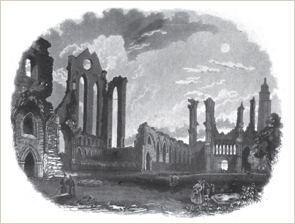
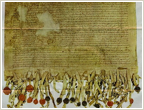
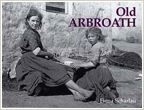
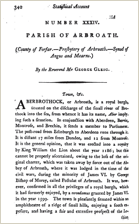
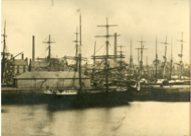
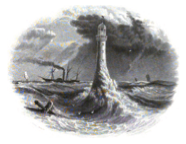
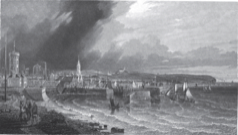
**********
PARISH OF ARBROATH.
PRESBYTERY OF ARBROATH, SYNOD OF ANGUS AND MEARNS.
THE REV. GEORGE GLEIG, MINISTER.
THE REV. WILLIAM STEVENSON, ASSISTANT AND SUCCESSOR. THE REV. JOHN COOPER, ASSISTANT.
(This Account has been drawn up by the Rev. Thomas Doig, Minister of Torryburn, formerly Assistant in this parish.)
I.—TOPOGRAPHY AND NATURAL HISTORY.
Name and Boundaries.—The ancient name of the parish was Aberbrothock, of which Arbroath is a corruption. Amongst the peasantry in many parts of the counties of Forfar and Kincardine, it is pronounced Arbroad. The original name is descriptive of the situation at the mouth of the Brothock, a small river, which here discharges itself into the German Ocean, and which, in the Gaelic language, is said to signify the muddy stream.
The parish is about three miles in length, varying in breadth from one to ten furlongs. Its extent may be estimated at 820 English acres, and in shape it may be said to bear some resemblance to a boot.
Topographical Appearances.—Within the limits thus described, there is nothing approaching in elevation to a hill. The ground rises gradually as it recedes from the shore, till at the farther extremity of the parish it attains to a height of about 160 feet above the level of the sea. The extent of coast is nearly a mile and a half. The shore is flat, with a rocky bottom, and forms the termination of the level coast, which extends eastward from the mouth of the river Tay. In the adjoining parish of St Vigeans, it assumes a very bold appearance, presenting a line of elevated rocks, with numerous caves and fissures.
Hydrography.—It may be noticed that there is a spring near the west end of the town of a chalybeate nature, and which, although now in a great measure overlooked, was at one time much resorted to. About two miles from the town there was formerly a small lake, which has been drained these many years. It still retains the name of Bishop's Loch. The only stream in the parish, with the exception of a small burn which falls into it, is the Brothock. Unless when flooded after rain, it discharges a very inconsiderable quantity of water into the sea. It takes its rise in the parish of St Vigeans, and, after a course of about six miles, enters the parish of Arbroath, through which it flows about a quarter of a mile, when it falls into the ocean. As the source whence the stream is gathered which drives a considerable number of spinning-mills, it is of no little value to the place.
Geology and Mineralogy.—The country part of the parish being a narrow strip of land, is distinguished by no peculiarity under this head which may not be described with more propriety in the account of the adjoining parishes of Arbirlot and St Vigeans. At the farther extremity, where the ground is from 140 to 160 feet above the level of the sea, the soil is thin, with a clay bottom; nearer the town of Arbroath it is black loam; and along the coast it is light and sandy.
Zoology.—The zoologist will find none of the more rare species of animals in the parish. In the neighbouring ocean is to be had an abundant supply of fish, consisting chiefly of the haddock, the cod, and the flounder, with herring and mackerel in their season. Stake-nets were erected a few years ago, in the hope of establishing a salmon fishery, but the success has not been such as to defray the expense. Shell-fish, viz. crabs and lobsters, are procured in great plenty.
II.—CIVIL HISTORY.
Illustrative of this department, there do not appear to be any ancient or modern accounts of the parish in print or manuscript, with the exception of a series of brief notices in the Arbroath Magazine,—a publication which was begun and ended in the year 1800. The only other historical or descriptive statements regarding Arbroath, are those to be met with in works which refer to Scotland in general. A "Description of the Abbey of Arbroath, by James Thomson," was published at Arbroath in 1829, which contains a good deal of interesting, and, seemingly, correct, information, in a condensed form.
Historical Events.—In ancient times, one of the most important of these was the celebrated Assembly of the Estates of Scotland, held in the Abbey in 1320, when a declaration was drawn up and signed, asserting the independence of the Scottish Church and kingdom, in language to which the Roman pontiff was not much accustomed in these days. In 1445; in consequence of a dispute about the election of a bailie of regality, a battle was fought near the town between the families of Lindsay and Ogilvie, in which the leaders of both houses fell, with about 500 of their followers. The next event of importance known to have taken place was the destruction of the buildings of the Abbey in the sixteenth century. The particulars have not been fully ascertained; only, the demolition appears to have taken place before the Reformation. Tradition says, it was accomplished by Ochterlony of Kelly, a proprietor in the neighbourhood, who had quarrelled with the monks, and had recourse to this method of avenging himself. In more recent times the town acquired a sort of notoriety, in consequence of a visit from one Captain Fall, commander of a French privateer, who appeared in sight with his vessel on the 23d May 1781, and commenced firing on the place. Having thus exhibited a specimen of his intentions, he sent several of his men, with a flag of truce, on shore, demanding L.30,000 Sterling as the ransom of the town, and six of the principal inhabitants as hostages till the sum should be paid. Considerable alarm followed. But at last, after a variety of proposals had been made, a few of the townsmen presented themselves on the beach with such fire-arms as could be most readily procured, and bade defiance to the threats of the privateer. After expending some more of his shot during the night, and finding next morning that he had done little or no damage, the captain made off in all haste, and found an opportunity of gratifying his desire of plunder, by making prizes of several sloops that fell in his way. A battery was afterwards erected in front of the harbour as a means of defence, but was dismantled after the last general peace.
Maps, Plans.—No separate map of the parish is known to exist. A plan of the town, including the suburbs in the parish of St Vigeans, was drawn, and published by Wood in 1822.
Letters, Papers, &c.—Of these, in the possession of resident individuals, and tending to illustrate the biography, history, or antiquities of the parish, there appear to be none. The ancient records of the burgh have been lost. Several papers, however, relating to the Abbey of Arbroath, which are the property of Lord Panmure, have of late been intrusted to the care of the magistrates, and are preserved among the existing records of the town. Amongst the documents in the possession of the kirk-session is a roll, beautifully written on parchment, dated 1445, exhibiting a statement of the dues payable from several crofts in the town and its immediate vicinity, for upholding lights in the Lady Chapel, which appears to have stood near to the present harbour. In this document the following streets and crofts are enumerated, viz. Neugate, Seygate, Neumarcatgate, Marcatgate, Grymysby, Mylgate, Lortburngate, Appylgate, Ratonraw, and Cobgate. These are all now built upon as streets, with the exception of Newgate, which is only partially occupied with houses. Grimsby was built upon during the latter part of the last century. To what extent the other places mentioned in the roll were built upon in the fifteenth century, we have no means of determining. In ancient times, Cobgate was the name given to that part of the High Street which is below, and Ratonraw to that part of it which is above, the present parish church.
Eminent Characters.—We are not aware of any distinguished warrior, statesman, or author, connected with the parish, either by birth or residence. It is the burial-place, however, of one of the kings of Scotland; William the Lion having been interred in the Abbey, which he founded.
Land-owners.—The superiority of the property is vested in the corporation of Arbroath.
Parochial Registers.—These consist of the kirk-session minutes, whose earliest date is 1669; and of the records of births and baptisms, and of marriage-contracts and marriages, which commence in 1659. They are in general in a good state of preservation. The entries of marriages are defective in 1659, 1661, 1696, 1697, 1698, and 1700; and of births and baptisms in 1660, 1661, 1696, 1697, 1698, 1699, and 1700; and the volume or volumes containing both, from 1735 to 1748 inclusive, have been lost. There is no record of the proceedings of the kirk-session from 1684 to 1732, nor from 1735 to 1748.
Antiquities.— Under the head of antiquities Arbroath has been long celebrated for the ruins of its abbey. This edifice was founded by King William the Lion in 1178, and dedicated to the memory of Thomas a Becket, Archbishop of Canterbury. The precincts of the abbey were inclosed with a stone wall from 20 to 24 feet in height; and formed an area 1150 feet in length from north to south, and in breadth 706 feet at the north, and 484 at the south end. At the north-west corner there is a tower, still entire, 24 feet square and 70 feet high, formerly used as the Regality prison. The ground-flat is now converted into a butcher's shop. Another tower, somewhat smaller, stood at the south-west corner of the inclosure; which, with the addition of a slated spire, served for many years as a steeple to the present parish church. Having become ruinous, it was taken down in 1830, and a remarkably handsome spire, 152 feet in height, has been erected in its place. The main entry to the area was by a stately porch on the north side. If it had not been that, a few years ago, the vaulting was taken down under an apprehension of insecurity, this would have been entire. For defence it appears to have been furnished with a portcullis, which now forms the armorial bearings of the town of Arbroath. There was another entry, but far inferior in architectural display, at the south-east corner, known by the name of the Darngate. A considerable portion of the north side of the inclosure was occupied by the abbey church. The dimensions of this building were,—length, 270 feet; length of transept, 132 feet; of the nave, 148 feet; and of the choir, 76 and one half feet; breadth of transept, 45 and one half feet; of the central aisle, 35 feet; and of each of the side aisles, 16 and one half feet. From marks, visible on the walls, the height from the pavement to the roof appears to have been 67 feet. The building is now in a state of ruin. All that remains is the south wall, with part of the east and west ends. A portion of the two western towers still exists in a very mutilated condition. The great entrance at the west end of the church is entire, with indications of a circular window above. A similar window, on a smaller scale, is to be seen in the upper part of the wall of the south transept. The other windows which remain are in the early-pointed or lancet-shaped style. The pillars which supported the roof of the church are all demolished; but their foundations may be traced without difficulty. Adjoining to the south transept, on the east, is a building, said to have been the charter-house of the abbey. It consists of two vaulted apartments, the one above the other, in a state of good repair. Immediately in front of this, and of the south transept, appear to have been the cloisters; and at a short distance from the south wall of the nave, are the remains of the abbot's house, which is still inhabited as a private mansion. On the whole, the buildings, although, when entire, they must have had an imposing aspect, were inferior, in point of magnificence, to some others of which Scotland could boast. Little is known respecting the history of the abbey, although it was much celebrated in its day. The monks were brought from Kelso, and were of the Tyronensian order. The abbot exercised episcopal jurisdiction within his precincts, and had a seat in Parliament. Of those invested with this dignity, two may be mentioned as distinguished,—Gawin Douglas, who was afterwards bishop of Dunkeld; and Cardinal Beaton, who held this along with his other dignities, and who appears, during his incumbency, to have alienated part of the property of the abbey. After the Reformation, the revenues and unalienated possessions of this wealthy establishment were erected into a temporal lordship in favour of Lord Claude Hamilton, third son of the Duke of Chatelherault. Lord Arbroath is one of the present titles of the Duke of Hamilton. These revenues afterwards came to the Earl of Dysart, from whom Patrick, first Earl of Panmure, in 1642, purchased them, including the patronage of thirty-four parish churches. In Thomson's account of the abbey the following statements are given of the revenues at the time of the reformation. "At the visitation of the monasteries in the years 1561 and 1562, by the commissioners appointed by the privy-council, the revenues of this establishment, as registered in the various books of the commissioners, were found in money and in kind to be: —1st, By the Register of the Collectors of the third of the ecclesiastical benefices, L.2483, 5s. Then, following, 2d, By the Register of Assumptions of the whole benefices, L.2553, 14s.
The first Table following is a statement of the diseases, of which the persons above enumerated are understood to have died. The statement depends altogether on the report of the relatives or friends of the deceased, and has therefore no pretensions to scientific accuracy; yet, as it may not be wholly useless, it is here exhibited.
The second following is a tabular view of the population in 1831, above 20 years of age, exhibiting the number of persons who are single, married, and widowed.
N. B.—Of the population under twenty years of age there are four males and four females married, and one female a widow.
Next is a tabular view of the number of families and houses.
Then the fourth following is a tabular view of the employments of the whole population of the parish of Arbroath. (On this subject, some more tabular details will be found in the original MS.)
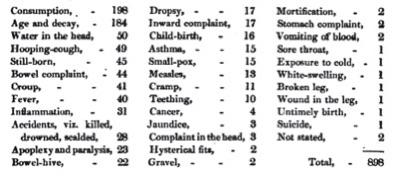
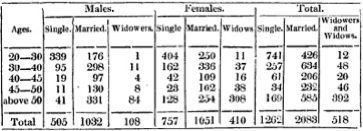
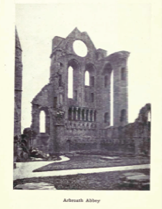

The yearly average of births recorded during the last seven years is 197; to which may be added 20 as the average of those not recorded, making in all an average of 217 births yearly, or 1 to 32 of the existing population. For the same period, the yearly average of marriage-contracts, where both parties resided in the parish, was 39 and five sevenths; where the man only resided, 13 and one seventh; and where the woman only was resident, 15 and four sevenths. It is only since the beginning of the year 1828 that a register of burials has been accurately kept. During a period of four years from that date, there have been interred in the church-yard of Arbroath, on an average each year, 140 and one half persons who died in the parish; 73 and one half who died in the suburbs of the town, in St Vigeans' parish; 7 and one half who died in the country part of the parish of St Vigeans; and 3 who died elsewhere. Probably 10 persons may die annually in the parish of Arbroath, who are interred elsewhere. This would exhibit 150 deaths yearly in the parish, or 1 out of 46 of the existing population.
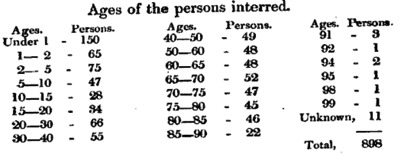


Omitted, capons, grassums, dawikis, and all other services and small duties, as also the dependent churches of Abernethy, Monifieth, and Tannadice." A Latin rent roll in the Book of Assumptions, which was returned soon after 1561, gives, in addition to the salmon, three barrels of glyssort (grilses), and the valuation of the churches of Abernethy, Tannadice, and Monifieth, thus:—Abernethy, L.273; Tannadice, L.237, 5s. 4d.; Monifieth, wheat, 4 ch. 12 bolls; bear, 12 ch. 9 bolls; meal, 15 ch. 10 bolls. The books, both of surplus and annexation of the third of the ecclesiastical benefices, give L.2594 as the money revenue; and in all the other articles they agree with the registers of the collectors and of assumptions, except in the single article salmon. In 1530, the order issued for the yearly provision for the abbey was, to purchase 800 wedders, 180 oxen, 11 barrels of salmon, 1200 dried cod fish, 82 chalders of malt, 30 of wheat, and 40 of meal, in addition to the rent in kind paid by the tenants. This may seem extraordinary, inasmuch as the number of monks was only twenty-five. But it is accounted for when we consider that visitors of all ranks, including at times the king himself, with a retinue of nobles, were gratuitously entertained in such establishments. The churches, the patronage of which belonged to the abbey, were Arbroath, Arbirlot, Panbride, Lunan, Congschollis, now Inverkeillor, Inverkeillor or St Murdoch's, Monikie, Murroes, Mains, Monifieth, Dunnichen, Clova, Ruthven, Glammis, Kirriemuir, Kingoldrum, Newtyle, Garvock, Dunivaig, Abernethy in Stratherne, Inverness, Mornack or Auchterarder, Banff, Gamry, Langley, Guild, Kingennie, Banchory or Trinity, Bethlehem or Bethelney, Forgue, Tyrie, Tarves, Nigg, and Fetterangus. In the year 1815, the Barons of Exchequer ordered the ruins of the abbey to be so far repaired as to preserve them from total dilapidation. On this occasion the rubbish was removed, and a portion of the pavement of the church again exposed to view. A search was also made with a view to discover, if possible, the tomb of the royal founder. The lid of a stone coffin was found, with the mutilated figure of a man in alto relievo. But no evident tokens of King William's sepulchre appeared, although, since that time, the old wily sexton has been accustomed to exhibit to credulous visitors a few mouldering bones in a wooden box as those of the monarch;—and, although bone after bone has been abstracted, new ones have always been found to supply their place.
Modern Buildings.—Dedicated to the purposes of religion, the most conspicuous of these are the parish church and chapel of ease. There is nothing, however, worthy of remark in the appearance of either. Only it deserves to be noticed that the spire of the church, which was rebuilt in 1831, is one of the most elegant structures of the kind to be seen in Scotland, and reflects much credit on the architect, Mr Henderson of Edinburgh. It is in what is commonly designated the Gothic style, and was erected at the expense of L.1300, a considerable part of which was raised by voluntary subscription. The Episcopal chapel has a plain exterior, but is neatly fitted up within. The dissenting meeting-houses are of a very homely aspect, but most of them, nevertheless, are groaning under a load of debt. The Town-house is a handsome building, erected in 1806. Besides the great hall, which is an elegant room, it contains an office for the use of the town-clerk and apartments for the meeting of the town-council and the small-debt court. In the upper part of the building is the prison, which is now made secure, and is kept in excellent order. The Guild-hall is a plain unostentatious edifice. The Trades-hall was erected in 1814, at an expense, the weight of which is still felt by the incorporations. The academy, built partly by private subscription in 1821, has a chaste appearance. (The building of the Abbey cost L.1600.) In front is an excellent playground for the scholars, Amongst the public buildings in the parish may be mentioned the Signal-tower for communicating with the Bell-Rock light-house, which is twelve miles distant, on a rock in the ocean. Several of these structures are built of stone brought from the shores of the Firth of Forth, whilst others are composed of a red sandstone from quarries in the immediate neighbourhood. Of this last kind of stone most of the houses in Arbroath are built. The colour, however, does not appear to be a favourite one, as many of the proprietors have lately painted the outside of their houses, so as to give them the appearance of a light gray. The town, as a whole, cannot be called handsome. Part of the High Street looks well; but most of the other streets are narrow. And although elegant houses are to be met with in most quarters of the town, the generality have a very ordinary appearance; and, in the cross streets, many of the houses are only one storey in height.
III.—POPULATION.
The registers of marriages and baptisms furnish the only means by which an estimate may be formed of the population of the parish in ancient times. Taking these as data, the number of inhabitants may be calculated to have been 1500 about the time of the Restoration, in the year 1660. At the Revolution, in 1688, the number appears to have been 1400. In 1707, the year of the Union, it had apparently risen to 2000 ; and in 1715, the year of the first Rebellion, to 2300. As the result of actual enumeration, the population is stated to have been 2098 in the year 1755; 3943 in 1776; and 4676 in 1792. The following [first Table below] are the returns which have been made since the commencement of the present century.
In the enumerations of 1801 and 1811, resident seamen are not included. In the three subsequent enumerations they are included. The increase which the returns successively exhibit may be ascribed chiefly to the establishment and extension of the staple manufacture of the place. Of the population, as above stated, nearly the whole must be viewed as belonging to that part of the town of Arbroath which is situated within the parish. Divided into town and country, the population at the following periods [second Table below] may be stated thus :—


